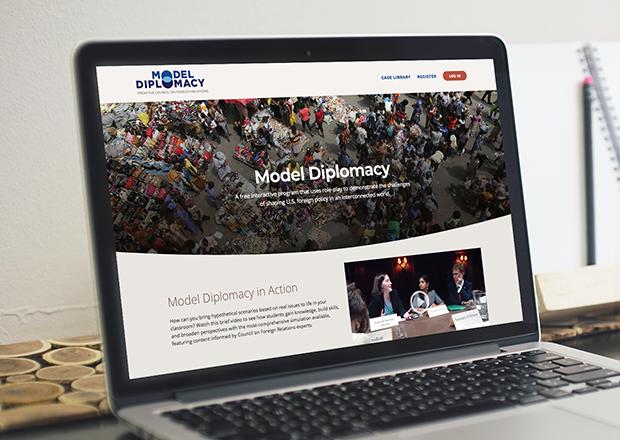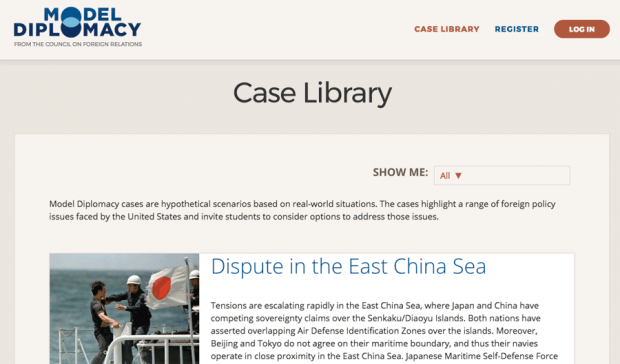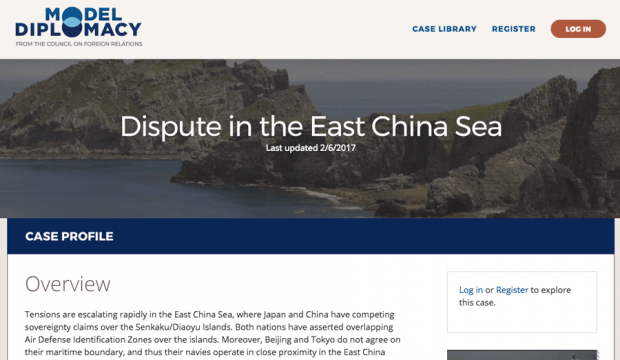 Support for Drupal 7 is ending on 5 January 2025—it’s time to migrate to Drupal 10! Learn about the many benefits of Drupal 10 and find migration tools in our resource center.
Support for Drupal 7 is ending on 5 January 2025—it’s time to migrate to Drupal 10! Learn about the many benefits of Drupal 10 and find migration tools in our resource center.What better way to teach students about foreign policy is there than compiling a library of hypothetical situations that influences them to think like a diplomat?
Model Diplomacy is an educational program created by the Council on Foreign Relations (CFR) designed to simulate the challenges involved in shaping U.S. foreign policy. The program provides teachers and students with educational material including course guides, authoritative multimedia content, supplemental research materials, and assessment exercises packaged into real-world case studies on different foreign policy issues. The program is used globally and in a variety of classroom settings.
“CFR is an independent, nonpartisan membership organization, think tank, and publisher dedicated to being a resource for its members, government officials, business executives, journalists, educators and students, civic and religious leaders, and other interested citizens in order to help them better understand the world and the foreign policy choices facing the United States and other countries. Founded in 1921, CFR takes no institutional positions on matters of policy.” - source: http://www.cfr.org
Model Diplomacy is able to put real content that has been developed by CFR experts into the hands of students, but before that can happen, that content must pass through the hands of a large number of editors. When CFR began working with Palantir, the Model Diplomacy site had already launched, however the editorial CMS was inefficient. Although they had no shortage of writers and content being created, it sometimes took up to a week to add, edit and publish a single case study.
Project Highlights
- Improved web design for public and admin site
- Improved editorial workflow
- Implementation of headless Drupal
- Implementation of advanced tracking for user flow analysis via Omniture

For Model Diplomacy, the urgent need was to streamline the editorial workflow, while improving the performance that was being delivered using AngularJS. Palantir re-platformed the site onto a more robust CMS, which in this case was a headless instance of Drupal 7. A headless instance allows Drupal to be used as a back-end for content editing while serving its content to the front-end application that is responsible for the look and feel of the site. Because of Drupal’s easy workflow, Model Diplomacy editors can now create content faster and maintain content easier.
As Model Diplomacy gained momentum and more stakeholders became involved in the project, it was time to rebrand and redesign the site. Palantir had three main goals for this phase of the project:
- Implement a responsive design that reflected the new Model Diplomacy brand.
- Introduce new functionality to streamline workflows even further.
- Implement advanced tracking analytics.
As the power users of the site, it was crucial to improve the administrative experience for instructors. One of the new features implemented during phase two was a dashboard for teachers to track their students’ progress. This dashboard introduced various new email capabilities, for instance, integrating with Mandrill from MailChimp to create triggers and send subsequent notifications to instructors and students based on content and editor publishes.
In addition to the redefined instructor communication workflow, Omniture was implemented to allow for user flow analysis. Actions and buttons on the redesigned site were instrumented as tags, which allows site administrators to see how students and teachers moved through tasks while using the site.
The overall victory for this project was the improved workflow for students, teachers, and content editors alike. We set out to help our client distribute and provide information easier, and on top of that, we were able to complete the project ahead of deadline, even including some last minute feature additions.
We want to make your project a success. Contact us.
Technical specifications
Content Access - to limit access to specific class groups, so that students can only access content appropriate to their courses.
Entity Reference - to create relationships between content, allowing for the proper display of course content as a collection of related readings and lessons.
Mandrill - for integration with rich email templates from MailChimp.
Media YouTube - for embedding YouTube videos on content pages.
RESTful - to create the API layer for communicating to the Angular JS front-end.
S3 File System - to provide file storage on Amazon's Simple Storage Service (S3).
Title - to enable the core title field to be converted to Field API for use with the RESTful layer.
Further context:
CFR runs multiple websites in Drupal, and Drupal 7 was common to all implementations at the time of the project. Using Drupal 7 instead of an early alpha of Drupal 8 allowed for faster development and simpler maintenance for the CFR team.
Since the Drupal instance was replacing the back-end of an existing web service, we chose modules that would support the existing functionality. Key among these was the RESTful module that provides the data API layer which replaced the original service.
The development team made bugfix contributions to the RESTful module, updating and improving the logic for access tokens, and correcting a bug related to deleting content.
Bill Sprowl

